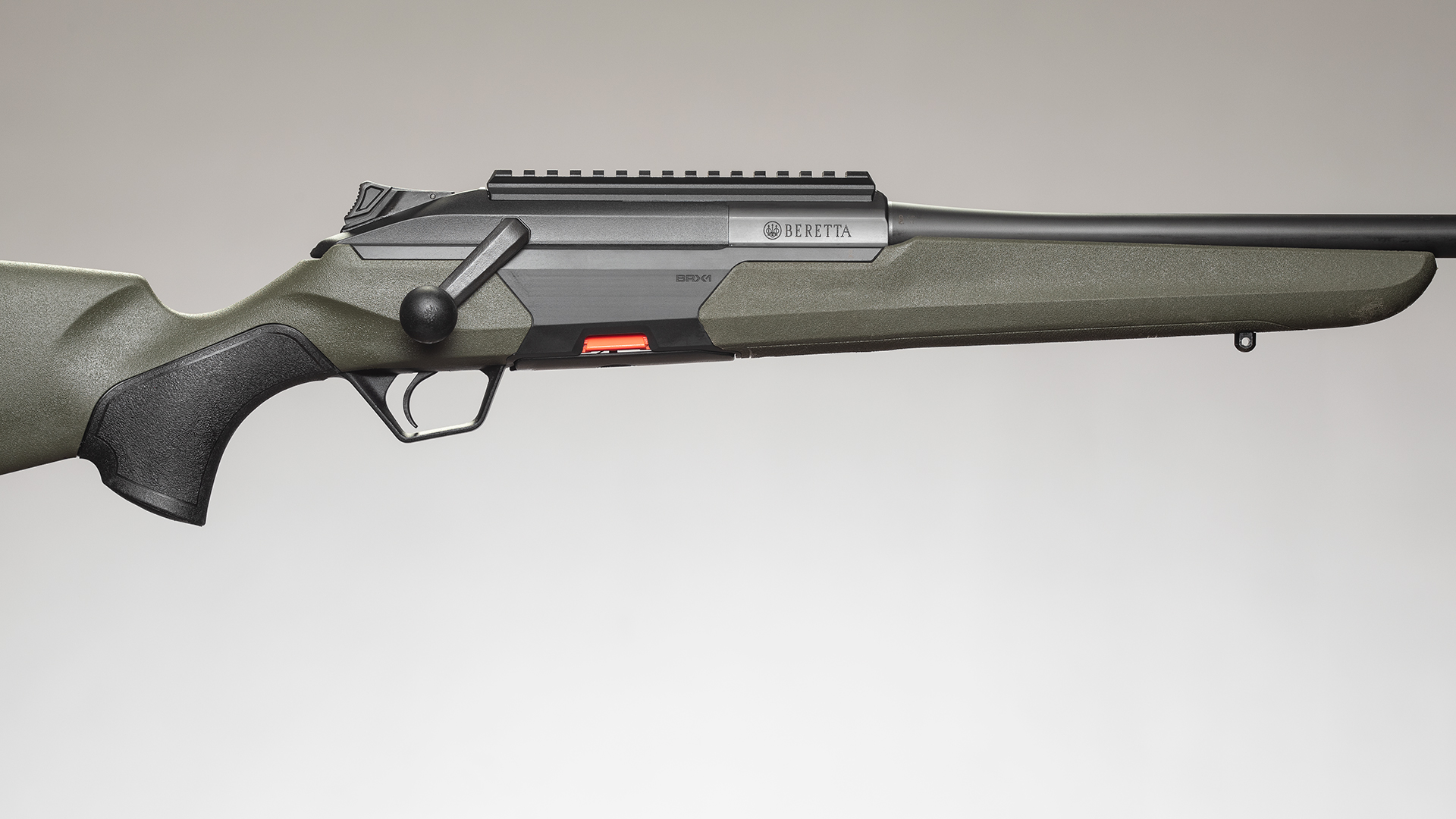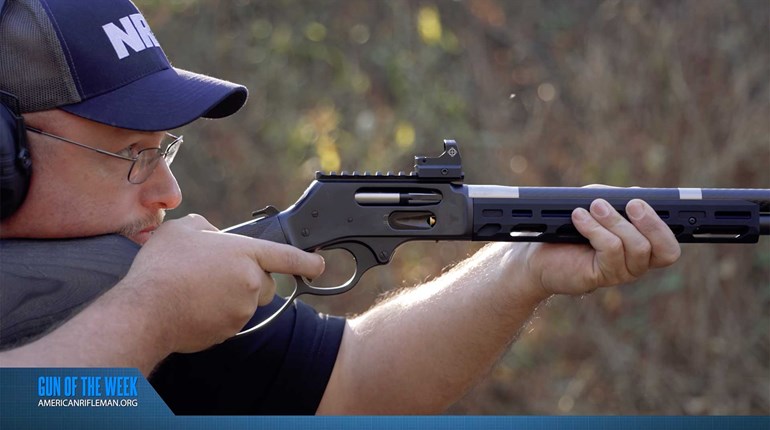
Straight-pull bolt-action rifles are not new. Mannlicher introduced one in 1886. Today, the design remains popular in Europe, where hunters like to carry speedy guns into the forests to shoot fast during driven hunts. Over there several gunmakers market such units. But over here hunting rifle design has for decades focused primarily on only one style: a turning bolt action, which remains queen of the American field.
Several straight-pulls sell well here, of course, including units from Blaser and Merkel and Savage’s Impulse. To this array Beretta added the BRX1, after its introduction in Europe some years ago.

Beretta calls the BRX1 the fastest manually operated repeating platform on the market. Ambidextrous controls make the rifle an attractive choice for lefties. Quick barrel, bolt and magazine swaps and adjustable ergonomics make it a distinct alternative to the classic turn-bolt for just about anyone.
Operation is simple and fast. Four movements required to operate a bolt-action rifle have been reduced to only two. On a turning-bolt design, a hunter grips the bolt by its knob to turn it up to unlock the bolt from battery; pulls the bolt to the rear to extract and eject a spent case; pushes the bolt forward to pick up a live cartridge from the magazine; then pushes down the bolt to lock the live round into battery. On the BRX1 a hunter grips the bolt to pull it to the rear then pushes it forward. Two steps—that’s it to shuck brass and chamber another round.
A rotating, multi-lug bolt head, same as used on the AR-15, does the trick. However, wherein the bolt group rides in an upper receiver in an AR, the bolt group of the BRX1 pretty much is the receiver. In standard calibers a single row of eight lugs surrounds its bolt head. In magnum calibers two rows of 16 lugs are present. The bolt glides back and forth on rails to open and close the action with little effort. There is no stickiness, no jerking rearward with great force. You can work the bolt with a flick of the wrist while only a finger grips the bolt knob.
A plump, round bolt knob is standard; optional knobs available from Beretta include a tactical version with vertical flutes and a hunting version with circular flutes. Both are fat, and made of black anodized aluminum.
The trigger is single-stage. It adjusts as advertised between three pull weights: 2.1 pounds, 2.6 pounds and 3.3 pounds. The trigger group is contained in a removable polymer cassette; a small slider on its side selects the pull weight.
Several features make the BRX1 a truly ambidextrous rifle.
First, dual-side ejection is possible because the angled bolt handle is reversible for right- or left-handed operation. Secondly, a sliding de-cocker with a hinged latch that enables fire-control, located at the rear of the bolt above the tang, may be operated by a right or left thumb. It moves between safe/de-cocked, bolt locked; safe but bolt moves to unload the gun; and cocked ready to fire. To move it forward and up two clicks from safe to fire takes considerable effort. Lastly, the double-stack magazine is manipulated ambidextrously as it’s held in place by locking tabs on either side. It works perfectly, clicking in and out of place on demand. It is proprietary, made of polymer, removable and fits flush with the belly of the stock. It holds five rounds in any caliber and may be topped off while seated in the stock. It’s orange, a fact that bothers some hunters because it stands out—but that’s exactly the point, says Beretta. Use it as a visual cue to tell you the part that holds live rounds is present—or not. Plus, you shouldn’t have any trouble finding it if you drop it on the forest floor.

The barrel is cold hammer-forged, measures 20 or 22 inches depending on caliber, and is threaded ⅝x24 TPI for suppressor fitment. It is fixed to the receiver with a V-shaped bedding block, two screws and one metal locking lug. It is interchangeable, and, thanks to its front-receiver extension and its optics rail interface an owner may swap barrels (and thus calibers)—without removing a zeroed scope—in about 30 seconds. The bolt head is easily replaceable, too, to adjust for different calibers. Though they aren’t listed on Beretta’s U.S. website, I am told caliber conversion kits are sold by the company that include a barrel, bolt head and magazine (if needed). Beretta says point of impact after barrel removal and reinstallation should shift no more than 1 MOA, if the barrel is installed correctly. The barrel extension accommodates three optics interfaces attached with one recoil lug and four screws. A Picatinny rail is factory mounted. Options include a Beretta Quick Coupler (quick-detach) mount and Tikka-style aluminum rail with a 17mm dovetail.
A rifle with a carbon fiber-wrapped barrel is also available for an additional $300. The use of carbon fiber, says Beretta, reduces overall weight of the rifle by 9.5 ounces, and increases barrel rigidity. Accuracy also is improved due to less warping and vibration of the barrel during firing. Consequently, barrel life should be improved due to increased cooling provided by the carbon fiber.
The three-piece polymer stock is molded in green or black and features a negative comb. The fore-end is built with cross-braces to create rigidity, and effectively free-float the barrel. Sling studs sit fore and aft. Modular design allows owners a bit of customization to personalize fit. Length of pull (on the long side at 14.5 inches) is adjustable by removing the Extralight buttpad then adding or removing .5-inch stock spacers. The pistol grip is interchangeable, too: An optional pistol grip available from Beretta fits the stock .59 inch closer to the receiver on its bottom edge than the standard grip to create a more vertical, more closed grip profile.
Currently, the BRX1 is available in three calibers: 6.5 Creedmoor, .308 Win. and .300 Win. Mag. Next year three more calibers will come online: .223 Rem., .30-06 and 7mm Rem. Mag. Beretta backs the gun with a three-shot, sub-MOA guarantee. My testing affirmed this—see the chart. See the groups fired with Sako Blade 162-grain Tipped Expanding Copper bullets—this is a hunting load! Besides these three loads, a Remington Premier Long Range and Sako TRG Precision load also grouped well. The barrel heats up too quickly. I wish it was fatter, and fluted to speed cooling; I’d accept the extra weight.
Wicked-fast operation makes the BRX1 attractive to the “firepower crowd.” Adjustable modularity makes it attractive to shooters who desire some customization. Truly ambidextrous capability makes it a great choice for lefties, who will discover they won’t break the bank to buy a rifle fit for them.

Technical Specifications
• Type: straight-pull, bolt-action centerfire rifle
• Caliber: 6.5 CM, .308 Win. (tested), .300 Win. Mag.
• Magazine: polymer; removable; 5-rnd. capacity
• Barrel: 20"; medium contour, cold hammer-forged; 1:10" RH twist; threaded ⅝x24; interchangeable
• Trigger: single-stage; adjustable 2.1 lbs., 2.6 lbs., 3.3 lbs. pull weight
• Sights: none; Pic rail installed
• Safety: three-position, tang-mounted
• Stock: polymer; negative comb; adjustable LOP
• Metal Finish: matte black
• Overall Length: 41"
• Weight: 7.1 lbs.
• MSRP: $1,599; beretta.com



































